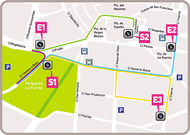Superblocks concept for access restrictions
Thematic areas
Demand & urban space management
- Access restrictions and management
- Road pricing
- Parking management and pricing
Summary
The city centre of Vitoria-Gasteiz suffered from heavy through-traffic. The municipality wanted to improve this situation through a redesign to change the flow of traffic and innovative access restrictions.
Implementing sustainable mobility
The main objective of this measures was to control the access to the city centre by a filter method compatible with the passing of the tramway (not traditional automatic bollards previously used) that will restrict crossing traffic, allowing entrance to the residents, commercial loading-unloading and services. Thus, the air and public space quality will be improved.
This measure also contributed to the superblocks concept, giving priority to the local traffic over the crossing traffic, and redistributing traffic flow from local streets to main roads.
The expected outcomes were:
- To reduce passing traffic inside the area up to 65% from the situation before CIVITAS.
- To reduce emissions of polluting gasses inside the area up to 10% from the situation before.
Progress
The first part of the work was devoted to define the control access scheme to be adopted for the experimental superblock. This phase implied a lot of political confrontation with many stakeholders on the basis of the proposal of schemes developed by the Municipal technical Offices. This phase lasted a quite long time, more than the expected, due to its difficulty but mainly to the delicate matter of the scheme and the proximity with the local elections, which made the politicians very cautious towards these kind of problems. This fact caused an initial delay to the measure, which was later recovered.
 According to the city ordinance, the following vehicles are allowed to move around the pedestrian area: vehicles of the Fire Fighting and Rescue Service, police, ambulance and general emergency vehicles, vehicles carrying sick or disabled persons, vehicles arising of a parking garage located in the area authorized, the authorized vehicles engaged in loading and unloading work in the streets and the hours so authorized and the vehicles specifically excluded from this prohibition by a motivated decision of the municipal authority.
According to the city ordinance, the following vehicles are allowed to move around the pedestrian area: vehicles of the Fire Fighting and Rescue Service, police, ambulance and general emergency vehicles, vehicles carrying sick or disabled persons, vehicles arising of a parking garage located in the area authorized, the authorized vehicles engaged in loading and unloading work in the streets and the hours so authorized and the vehicles specifically excluded from this prohibition by a motivated decision of the municipal authority.
It was very complex to tackle with these exceptions, mainly with the access of the vehicles to the parking, the vehicles that carrying sick of disabled persons (the vehicle can be of different persons of the family). With the city's current ordinance, the residents don’t have permission for the acces to the controlled area, being this the main cause of the delay as the politicians didn’t decide on a new regulation for access of the residents.
The adopted scheme consisted in that all the accesses to these streets, where traffic is prohibited, were indicated with the corresponding traffic signal (R-100 Circulation prohibited), with exceptions.
The automatic access control consists in reading the car plate number of all vehicles entering and leaving the city centre through an access control system based on cameras. The electronic system then recognises the car plate number using an OCR algorithm.
If the vehicle takes less than a certain time to cross the area, the system considers it as a passing vehicle and therefore the driver must be enforced. Otherwise, the vehicle is considered a resident or a goods distribution vehicle. With this system we control only the passing vehicle, being the Municipal Police who control the rest of vehicles that access to the controlled area.
In addition, there is a database of authorized vehicles to pass into the area, regardless the time journey. This “white list” of vehicles includes public transport services, municipal police, fireman vehicles, street cleaning service, etc.
Initially, during the time of loading and unloading for freight distribution, the system is off, in order to allow access for freight vehicles, because in this moment, there aren’t a registration list of freight vehicles, With this system, we will be able to realize this registration on the future.
Five cameras were installed: 3 entry cameras and 2 exit cameras, to control 4 different itineraries.
After the commissioning of the system of video cameras and the announcement that the vehicles not authorized would be fined, a campaign to disseminate the information about this measure to citizens was launched on the 19th of April 2012.
Outcomes
The objective to reduce passing traffic inside the superblock up to 65% from the situation before MODERN was achieved and even exceeded, mainly due to superblocks model and the tramway implementation (around-60%). This fact is very interesting, as it shows that a general policy of land use and of general regulation of the circulation coming from a physical urban organization, coupled with the availability of means to guarantee the access to the area (proper PT services), can give significant results without specific restriction actions.
Moreover, it is interesting to analyse the evolution of traffic flows during the information campaign. The trend of the number of vehicles entering into this area was always decreasing during the period between February and July, more for the total daily values than for the freight distribution time window, and more for some streets. So, this means that the information campaign worked properly.
Acceptance level was measured through direct surveys. 400 telephone interviews were done on the whole population over 16 years in Vitoria-Gasteiz. The acceptance level of this measure is not too high, the reason being the fact that the system is based on fines, which always have a negative impact on citizens.








